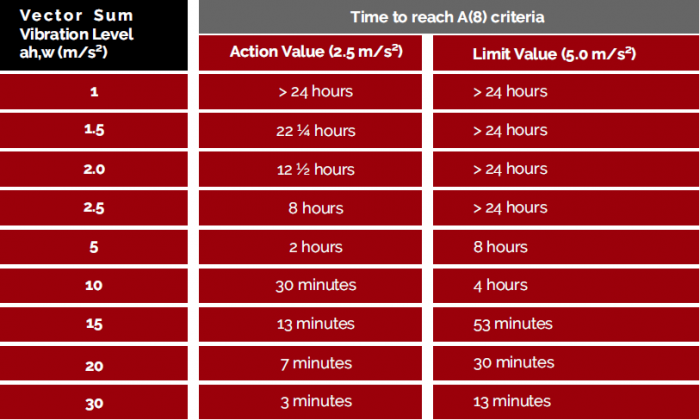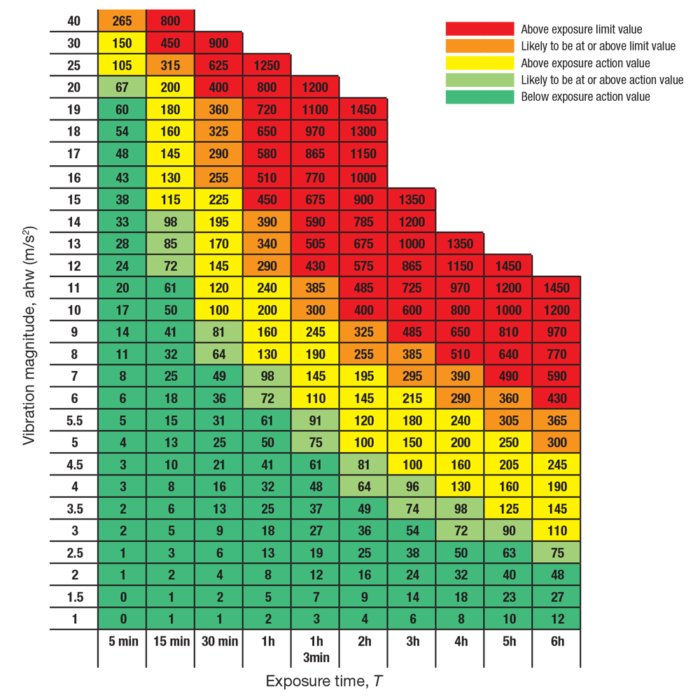What are the Vibration Exposure Limits and Values?
The Control of Vibration at Work Regulations 2005 is based around the concept of exposure, as it is the amount of vibration exposure, not just the amount of vibration that causes injury.
To calculate vibration exposure, you need to know the two key factors:
1. The vibration magnitude of your tools given in m/s2
2. Exposure times measured in hours or minutes
With these two figures, it is then possible to calculate the exposure figure, known as A(8) – the ‘8’ part is because this is all referenced to an 8 hour ‘normal’ working day, but don’t worry if people
work for less of more than 8 hours as the calculation explained a bit later on take care of this automatically.
Only with the A(8), can you then compare the exposure a person has received with the
regulations to determine whether or not further action is required. The following table shows the levels of exposure given in the Control of Vibration at Work Regulations 2005.

If it’s your responsibility to protect your workforce against against the injuries caused by Hand Arm Vibration, then read our Ultimate Guide to Managing Hand Arm Vibration in the Workplace
Vibration Exposure Action and Limit Values
Exposure Action Value – EAV
The Exposure Action Value (EAV) is set at 2.5m/s2 or 100 points and represents the level above which your organisation has legal responsibilities to carry out certain actions to ensure that this
employee is being protected from hand-transmitted vibration injury. It is important to note that this is NOT a safe level, so you can still expect some people to suffer injury even if the value is
not exceeded. The actions, in basic form are:
- Make every effort to reduce the exposure to below 2.5m/s2 by organisational (job rotation) or technical (vibration engineering) measures.
- Carry out Health Surveillance as exceedance of this level is indicative of the person being at risk, which is the threshold for health surveillance in the regulations
- Provide Information, Instruction and Training as described in the HSE guidance and which is covered under Step 5 later on in this document
Exposure Limit Value – ELV
The Exposure Limit Value (ELV) was a new concept when it was built into these regulations. Set at 5m/s2 or 400 points for Hand Arm Vibration, this is the maximum level of vibration that an
employee may be exposed to in any 8 hour period and there are no exceptions! What this means in practice is that if someone is found to be exceeding this level of exposure, then work must immediately stop and actions must be taken to make sure it doesn’t happen again.
Daily Exposure – Aeq ‘v’ A8
The main actions required by the law are based on assessing the A(8). This is an often misunderstood, yet fundamental point, which if not observed, will invalidate any risk assessment.
In fact, vibration exposure is just like any other form of exposure, for example, dust, gas, radiation and even sunlight.
Take an example of sunlight. If the average strength of the sun is measured over the course of a day (call it 8 hours), this will give a figure showing how strong the sun is. This does
not however say anything about how brown (or burnt) a person might get as this, in turn depends on how long they stay in the sun. If the sunbather spends 4 hours in the sun, then they have had half of the available sunlight so it would be logical to take half of the number as the exposure figure.
The same principle applies to vibration exposure, where Aeq is a measure of the level that exists at the surface of a tool or seat. This can be measured using a Vibration Meter such as the
Castle Vexo H. The A(8) is then the proportion of that Aeq relative to the time of exposure. There is a formula to calculate this as it is not simply a direct proportion, but the principle is the same.
The relationship between the measured level (Vibration magnitude) and time spent exposed, for both the action value and the limit value, can be shown as follows and what the graph shows is
that as your exposure time increases, the level of vibration allowed for that time decreases along the curves shown. For example, if you look at 8 hours and read up to the lines, you will see that
they meet at 2.5 for the Action Value, and 5 for the Limit Value. Then you can see that if an employee works for less time, the level they can be exposed to goes up and, conversely, if they
work for longer, the level allowed goes down.
Looking at the same information as a table below, you can see that the exposure halves if you quarter the trigger time. This is due to the nature of the square-root part of the equation and means
that if you want to limit someone’s usage time on a tool, then you will have to significantly reduce the time, to have much effect at all on the exposure.

HSE Exposure Points System and Ready-Reckoner
As long as you have a vibration magnitude level and an accurate exposure time, translating this into HSE exposure points in easy. For the most common exposure times and vibration magnitudes you can use the table below. Simply cross reference your exposure time with your vibration magnitude and you can not only find the exposure points, but also which category the points falls in.

For example, an operator working for three hours on a tool emitting a vibration magnitude of 9m/s2 would translate into 485 points.
Learn more about vibration exposure on our Hand Arm Vibration Safety Course
or
Download our FREE Hand Arm Vibration Training Webinar
-

Castle Products
CLICK HERE FOR
Information, technical data, images and pricing of all Castle Group Ltd. products -

Product Rental
CLICK HERE FOR
Hire the best equipment at a fraction of the purchase price -

Calibration Lab.
CLICK HERE FOR
Calibration and repair services from Air Samplers to Vibration Meters -

Training
CLICK HERE FOR
World class safety and environmental courses. On your site or our 4* training facility -

Consultancy
CLICK HERE FOR
Employ our expertise for both simple and more demanding issues.












